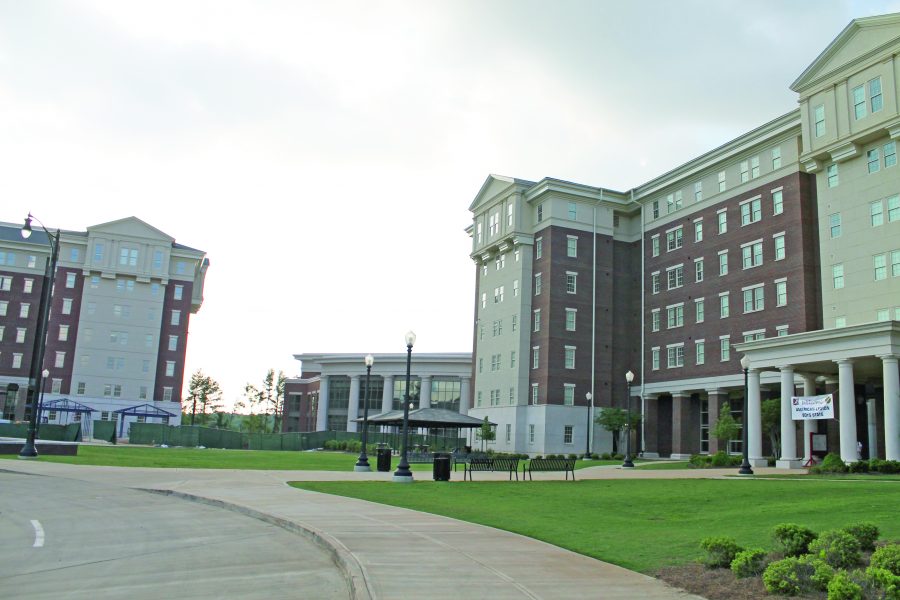Su Gupta, associate professor of metallurgical and materials engineering, directs a campus-wide user facility called the UA Micro-Fabrication Facility. If you look for it today, you can find it in the Bevill Building.
“Part of H. M. Comer Hall, that originally housed the MFF, had to be demolished to make room for NERC, so the facility had to be temporarily relocated to the MINT clean room in Bevill for three years,” she said. “I am grateful that the Vice-President of Research provided funds for the temporary set-up of the facility in Bevill, which allowed us to remain functional for the past three years.”
Ultimately, the MFF will be housed in the North Engineering Research Center, forcing a second move to a “beautiful, large clean room facility.” Shelby Quad was completed last August after nearly 10 years of construction and four new buildings.
“The progress and growth of campus is very impressive, especially with the completion of the Shelby Science and Engineering quad last summer,” Gupta said. “I am very glad the engineering [facilities are] mostly complete. I am very happy with the new clean room facility and cannot wait to become fully functional in there, by August we hope.”
She said bringing facilities and equipment on line has been a little slow, but she expects the process to be complete by the end of the summer. While the sights and sounds of construction may be leaving the Shelby Quad, students can expect work around the adjacent Ferguson Center area to continue throughout the summer.
Tim Leopard, assistant vice president of UA Facilities, said there is an intentional effort to increase construction activity during the summer, when fewer students will be impacted.
“The level of construction definitely impacts the access and usability,” he said. “[One] of our core goals for our projects is to minimize any potential impact to the teaching and learning environment.”
In addition, Leopard said, communications concerning construction are added. Signs directing visitors and newsletters for faculty are used to inform and update, while the Campus Tour section of the UA website offers information about road closures.
According to Dialog, the faculty/staff newsletter, the expanded building will include office space for the Career Center, Community Service Center, Crossroads Community Center, Greek Affairs, Student Government Association, Student Involvement and Leadership and University programs. There will also be a renovated food court, with the Fresh Foods Company that was previously located in the Ferguson Center moving across the street to its own building.
Cathy Andreen, director of media relations, said the Ferguson Center will reopen in August. For the summer, offices have temporarily relocated across campus.
“All areas of Ferguson are closed this summer except for the SupeStore, Mail Center and Starbucks,” she said.
Leopard said students can expect any disruption or inconvenience in the Ferguson Center and Shelby Quad area – as well as around Presidential Village, where a new residential hall will be open next semester – to be gone by the fall, but construction on other parts of campus will be ongoing.
“The Magnolia area and Barnwell area will continue to be challenged,” he said. “We’re starting a new parking deck there [and] we’re [starting construction on] more sorority houses there, so that area will continue to be busy, as will the Coleman Coliseum baseball area once we start baseball construction.”
The $35 million expansion of the Sewell-Thomas Stadium is one of several projects detailed in Dialog, including a 2,000 seat academic building behind Shelby Hall – slated to begin construction in early 2015 – and a performing arts center on Bryce property.
Leopard points to the renovation of Houser Hall, scheduled to be completed by August 2015, as an example of the type of construction happening on campus. The new building will house the expanded services of the Veteran’s and Military Affairs Center, just as the Ferguson Center addition will house expanded services in the Career Center. Campus construction is about more than just growth, he said.
“I think all of [our projects], or almost all of them, represent meeting or improving existing program services and accommodating growth. The programs are growing, too,” he said. “I think all of our projects bridge between [meeting existing needs and growth].”
(See also “Expansion ongoing at Ferguson Center“)









